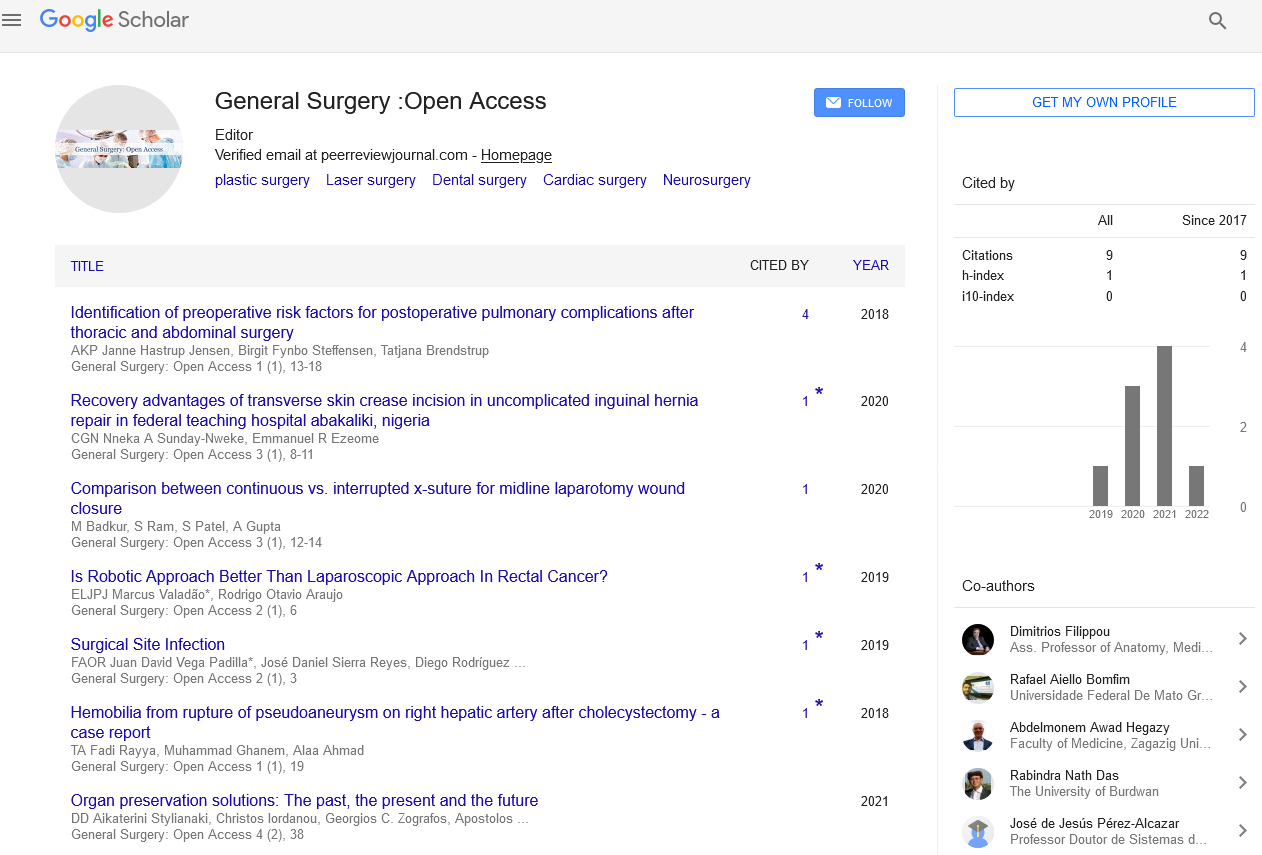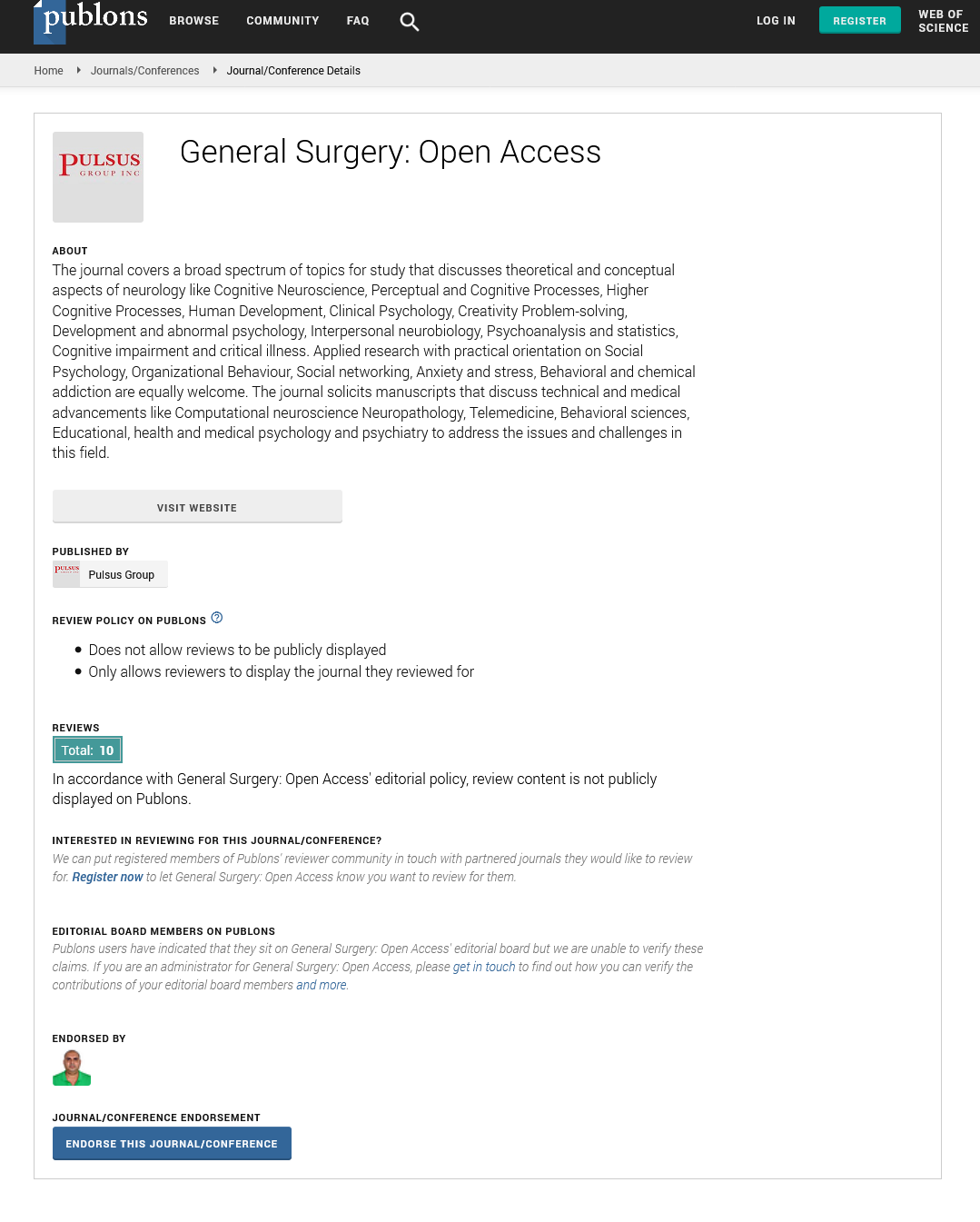Research on diabetes mellitus: The results and quality of pancreatic islet cells isolated from surgical samples
Received: 03-Aug-2022, Manuscript No. PULGSOA-22-5224; Editor assigned: 05-Aug-2022, Pre QC No. PULGSOA-22-5224; Reviewed: 19-Aug-2022 QC No. PULGSOA-22-5224; Revised: 03-Oct-2022, Manuscript No. PULGSOA-22-5224; Published: 10-Oct-2022
Citation: Smith D. Research on diabetes mellitus: The results and quality of pancreatic islet cells isolated from surgical samples. General Surgery: Open Access 2022;5(3):1-2.
This open-access article is distributed under the terms of the Creative Commons Attribution Non-Commercial License (CC BY-NC) (http://creativecommons.org/licenses/by-nc/4.0/), which permits reuse, distribution and reproduction of the article, provided that the original work is properly cited and the reuse is restricted to noncommercial purposes. For commercial reuse, contact reprints@pulsus.com
Abstract
For diabetes research, a substantial number of high quality human islets must be isolated. Since human islets are often only available from brain dead donors, study is made challenging by their scarcity. After surgical excision, pancreatic tissue that is discarded may make a suitable alternate supply of islet cells. We separated islets from surgical materials that were discarded in order to verify this idea. We next assessed the quantity, quality, and preparations of islet cells. Utilizing the automated Ricordi technique, 82 segmental pancreases were processed, and islet yield and quality were examined. 32 individuals with diabetes made up the group, with a mean age of 54.6 patients. Following purification, partly resected pancreases produced an average of 71.5 21 percent pure Islet Equivalents (IEQs) and 2546 IEQ/g of digested pancreas. Diabetes (p=0.0046) and the lobe employed (p=0.0156) were found to substantially impact islet yield by multivariate analysis.
Despite the fact that these outcomes depended on the islet quality, islets transplanted into diabetic mice showed good survivability, in vitro glucose responses, DNA/RNA quality, mitochondrial activity, and glucose management. Even after being frozen, isolated cells still exhibited good vitality and functionality. According to our research, pancreatic tissue that is discarded during surgery might be a useful source of islets for studies into diabetes.
Introduction
Important resources for diabetes research include isolated islets of langerhans cells and human pancreatic tissue. Human islets have been utilised to examine many different facets of endocrine physiology and diabetes, including islet shape, genetics, insulin and glucagon release, transcription factor regulation, transplantation, and many other topics. Compared to rodents, huge animals have a very different pancreas. Some examples of the islets' characteristics include their size, shape, and connection to the exocrine tissue around them. factors that differentiate islet isolation for each species. The age, volume, and state of the exocrine pancreas can all have a substantial impact on how the islet isolation operation turns out, even within the same species. Isolating islets from the human pancreas is a challenging and delicate technique that needs a specialised facility that has the appropriate permits and the joint efforts of several skilled individuals. Even though human islet isolation methods have continuously advanced, it is still challenging to extract enough islets from a single donor pancreas [1].
There are several variables that affect islet yields, including those linked to the donor, pancreas, and isolation. We already discussed our experiences with isolating individuals in our study. Islets from human cadaveric donors and our examination of isolation characteristics and preexisting donor parameters that might influence the outcomes of human islet isolation [2].
Research on islet cells for diabetes therapy is challenging since human islets are normally extracted from the pancreas of a cadaveric donor. This is especially true in nations that forbid the use of organs obtained from cadaveric donors for research purposes. Despite this, even in nations that permit the use of such organs for research, islet availability is frequently limited. While it is possible to get pancreatic islets from living donors who have had a partial pancreatectomy, this has only been briefly mentioned in the literature, and the studies that did so lacked sufficient information. arlier said, the It is challenging to reliably isolate islets successfully, especially in surgical settings, due to the heterogeneity of donor and pancreatic tissue characteristics [3].
Therefore, the purpose of this study was to assess the amount and quality of the isolated islets to assess the potential utility of surgical specimens from pancreatectomized patients as an alternate source of human islet tissue. We assessed the quality of islet samples taken from pancreases that were discarded during surgery. Our findings indicate that islets may be successfully isolated from specimens after partial pancreatectomy [4].
Discussion
In order to make progress in the search for cutting-edge treatment options for diabetes, access to human pancreatic islets is essential. However, the scarcity of human pancreatic islets from live or cadaveric donors limits research on human beta-cells. Researchers have employed the Laser Capture Microdissection (LCM) of pancreatic tissue to examine the pathophysiology of islets in diabetes because it is difficult to get human islets for diabetic research. Despite the fact that LCM makes it possible to gather gene expression data for analysis, it does not offer enough live cells for functional and proteomic analyses. In this case, acquiring live islet cells from removed pancreatic tissue following surgery to treat benign pancreatic disorders can be a useful tool for regenerative medicine. researchers looking at diabetes. The procedure and results of separating islets from surgical specimens have been covered in comparatively few research, and results pertaining to the quality of the islets obtained from surgical specimens are rarely documented. The 24 partly pancreatectomized individuals' islets were isolated using various techniques along with succinct functional analysis. We have demonstrated in this work that surgically removed tissues may be used to create high quality human islets. Additionally, we have assessed the isolated human islet material's viability, functionality, mitochondrial characteristics, nucleic acid extraction, cryopreservation, and in vivo attributes to ensure that it is suitable for various diabetic research regrettably, we just lately understood the necessity of systematic quality testing, thereforeonly able to assess the quality of islets in part of the samples. 42.2% of the cohort of patients had type 2 diabetes, and their islets were collected in the same way as those who did not have the disease. The grade of islets obtained from diabetic donors was on par with that of islets obtained from people without diabetes. Studies conducted in the past with pancreatic tissue from brain dead donors [5].
Conclusion
Our research suggests that following cryopreservation, islet cells extracted from pancreases that had undergone partial surgical resection displayed good islet form, function, cellular composition, and recovery. For islet cell research on the treatment of diabetes, this technique can be a useful supply of cells.
References
- Shapiro AJ, Lakey JR, Ryan, EA. Islet Transplantation in seven patients with type 1 diabetes mellitus using a glucocorticoid-free immunosuppressive regimen. N Engl J Med. 2000;343(4):230-8. [Crossref] [Googlescholar]
- Lyon J, Manning Fox JE, Spigelman AF, et al. Focused isolation of human islets from donors with and without diabetes at the Alberta diabetes institute Islet core. Endocrinology. 2016;157(2):560-9. [Crossref] [Googlescholar] [Indexed]
- Lakey JR, Burridge PW, Shapiro AJ. Technical aspects of islet preparation and transplantation. Transpl Int. 2003;16(9):613-32. [Crossref] [Googlescholar] [Indexed]
- Bellin MD, Balamurugan AN, Pruett TL, et al. Sutherland DE. No islets left behind: Islet autotransplantation for surgery-induced diabetes. Curr Diab Rep. 2012;12(5):580-6. [Crossref] [Googlescholar] [Indexed]
- Redfearn DP, Trim GM, Skanes AC, et al. Esophageal temperature monitoring during radiofrequency ablation of atrial fibrillation. J Cardiovasc Electrophysiol. 2005;16(6):589-93. [Crossref] [Googlescholar] [Indexed]
Keywords
Pancreatic islet; Human islet isolation; Diabetes; Partial pancreas; Surgical specimens






